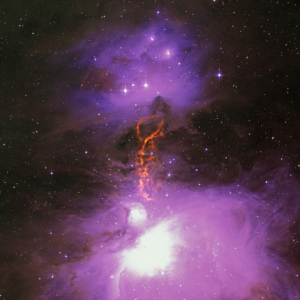A composite radio-optical image shows five new clouds of hydrogen gas discovered using the Green Bank Telescope. The spiral galaxy M81 and its satellite, M82, are seen in visible light (white); the new hydrogen gas is colored red; and additional hydrogen gas earlier detected by the Very Large Array (green). The M81 Group of galaxies, 11.8 million light-years from Earth, are interacting gravitationally with each other, as shown clearly by the gas streaming among them. The newly-discovered gas clouds, each containing from 14 to 57 million times the mass of our Sun, are similar to gas clouds near our own Milky Way Galaxy. They are likely remnants of earlier interactions among the galaxies. Probably, the Milky Way has had a similar history.


The Collision of UGC 813 and UGC 816
The “Taffy” galaxies are the results of a collision between two galaxies, UGC 813 (right) and UGC 816 (left). They were normal disk galaxies before they collided face-on at a speed of one million miles per hour about 50 million years ago. The disks of stars and dense clouds of molecular gas passed through each other relatively unharmed and are now separating. Diffuse HI gas clouds were stopped between the galaxies or thrown out in long tails, shown in blue. Disk magnetic fields are anchored by dense molecular clouds and are being stretched like bands of taffy between the galaxies as they separate. This bridge produces the radio continuum emission depicted in red.

Pebble-Size Particles May Jump-Start Planet Formation
Radio/optical composite of the Orion Molecular Cloud Complex showing the OMC-2/3 star-forming filament. GBT data is shown in orange. Uncommonly large dust grains there may kick-start planet formation.

The supermassive black hole at the center of the Milky Way.
New evidence has been uncovered for the presence of a faint jet of high-energy particles blasting out of the Milky Way’s relatively quiet supermassive black hole known as Sagittarius A* (Sgr A*). This image of Sgr A* and the region around it contains some of the data used in the study, with X-rays from Chandra (purple) and radio emission from the Very Large Array (blue). Jets of high-energy particles are found throughout the Universe on large and small scales. The likely discovery of a jet from Sgr A* helps astronomers learn more about the giant black hole, including how it is spinning.

The supermassive black hole at the center of the Milky Way.
New evidence has been uncovered for the presence of a jet of high-energy particles blasting out of the Milky Way’s supermassive black hole known as Sagittarius A* (Sgr A*). This image of Sgr A* and the region around it contains radio emission data from the Very Large Array. Jets of high-energy particles are found throughout the Universe on large and small scales. The likely discovery of a jet from Sgr A* helps astronomers learn more about the giant black hole, including how it is spinning.

The Center of Our Galaxy
The Very Large Array (VLA) was used to make the largest and most sensitive radio image of the Milky Way Galaxy’s center. The bright diagonal features trace our Galaxy’s disk-like shape viewed edge-on. The brightest source is called Sagittarius A. (The Galaxy’s center lies toward the constellation Sagittarius, or Sgr.) Deep within Sgr A is Sgr A*, a black hole with a mass millions of times that of the Sun. Hot young stars heat the gas around them in bright, round blobs. Massive supernovae explosions leave bubble-shaped remnants. Spiraling or synchrotron radiation makes a collection of strange, thread-like structures. Their emission, orientation, and structure provide important clues about the energetics and large-scale magnetic field structure.





